Prunus americana (Wild Plum)
| Also known as: | American Red Plum |
|---|---|
| Genus: | Prunus |
| Family: | Rosaceae (Rose) |
| Life cycle: | perennial woody |
| Origin: | native |
| Habitat: | part shade, sun; fields, prairies, woolands, forest edges, roadsides, along shores |
| Bloom season: | May |
| Plant height: | 10 to 25 feet |
| Wetland Indicator Status: | GP: UPL MW: UPL NCNE: UPL |
| MN county distribution (click map to enlarge): |  |
| National distribution (click map to enlarge): |  |
Pick an image for a larger view. See the glossary for icon descriptions.
Detailed Information
Flower: 

![[photo of flowers]](/udata/r9ndp23q/pd3/prunus-americana-002-t.jpg) Numerous convex to nearly globe shaped clusters from buds at the tips of branches, each cluster a 1 to 4-flowered umbel (stalks all arising from the same point) and emerging before the leaves in spring. Flowers are ¾ to 1 inch across with 5 white, round to egg-shaped petals with a single slender style and a spray of white, slender yellow-tipped stamens in the center.
Numerous convex to nearly globe shaped clusters from buds at the tips of branches, each cluster a 1 to 4-flowered umbel (stalks all arising from the same point) and emerging before the leaves in spring. Flowers are ¾ to 1 inch across with 5 white, round to egg-shaped petals with a single slender style and a spray of white, slender yellow-tipped stamens in the center.
![[photo of sepals and clusters]](/udata/r9ndp23q/pd3/prunus-americana-004b-t.jpg) The 5 sepals are green to red, about 1/3 the length of the petals, lance-oblong, rounded at the tip and spreading or reflexed downward. The edges lack glands or have just a few at the tip; the inner surface is hairy and the outer hairy or smooth. Flower stalks are slender and hairless.
The 5 sepals are green to red, about 1/3 the length of the petals, lance-oblong, rounded at the tip and spreading or reflexed downward. The edges lack glands or have just a few at the tip; the inner surface is hairy and the outer hairy or smooth. Flower stalks are slender and hairless.
Leaves and bark: 

![[photo of leaves]](/udata/r9ndp23q/pd3/prunus-americana-87-17-t.jpg) Leaves are simple and alternate, the blade elliptic to oblong-elliptic, 2 to 4 inches long and 1¼ to 1¾ inches wide, the tip abruptly tapered to a point, and rounded at the base onto a 1/3 to 2/3 inch, hairy stalk. Upper surface is dark green, hairless or becoming hairless, the lower surface is lighter and somewhat hairy. Edges are sharply toothed, often doubly, but lack any glands except for a few at the edge of the leaf blade near the stalk.
Leaves are simple and alternate, the blade elliptic to oblong-elliptic, 2 to 4 inches long and 1¼ to 1¾ inches wide, the tip abruptly tapered to a point, and rounded at the base onto a 1/3 to 2/3 inch, hairy stalk. Upper surface is dark green, hairless or becoming hairless, the lower surface is lighter and somewhat hairy. Edges are sharply toothed, often doubly, but lack any glands except for a few at the edge of the leaf blade near the stalk.
![[photo of twig]](/udata/r9ndp23q/pd3/prunus-americana-15-19-t.jpg) Twigs are reddish brown to gray with a flaking waxy cuticle the second year, typically smooth but occasionally persistently hairy. Branches are wide-spreading with older lateral twigs developing into stout spines up to 2½ inches long.
Twigs are reddish brown to gray with a flaking waxy cuticle the second year, typically smooth but occasionally persistently hairy. Branches are wide-spreading with older lateral twigs developing into stout spines up to 2½ inches long.
![[photo of older, flaking bark]](/udata/r9ndp23q/pd3/prunus-americana-15-18-t.jpg) Older bark is dark gray, initially forming irregular ridges that later develop into hard, curling strips.
Older bark is dark gray, initially forming irregular ridges that later develop into hard, curling strips.
Fruit: 
![[photo of fruit]](/udata/r9ndp23q/pd3/prunus-americana-87-32-t.jpg) Fruit is a purplish red drupe with a thin waxy bloom, about 1 inch in diameter with a single hard seed inside.
Fruit is a purplish red drupe with a thin waxy bloom, about 1 inch in diameter with a single hard seed inside.
Notes:
A shrub or small tree, Wild Plum is common throughout our prairie and central hardwoods regions. Historically fire suppressed, it has expanded its presence into open prairie and man-made forest margins and openings where it can produce large, dense thickets through its suckering root system. Similar to Canada Plum (Prunus nigra), which is primarily a forest species that has blunt teeth on leaves and glands on the upper leaf stalk, where Wild Plum has sharp teeth, and glands on the edge of the leaf blade.
Native Plant Nurseries, Restoration and Landscaping Services ↓
More photos
 Wild Plum
Wild Plum an expanding thicket of Wild Plum in prairie habitat
an expanding thicket of Wild Plum in prairie habitat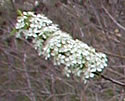 Wild Plum in a park landscape
Wild Plum in a park landscape spiny branch
spiny branch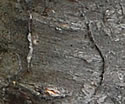 bark forming ridges
bark forming ridges developing fruit
developing fruit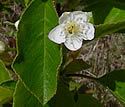 Wild Plum sucker
Wild Plum sucker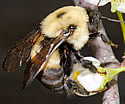 Bombus griseocollis Queen on Wild Plum
Bombus griseocollis Queen on Wild Plum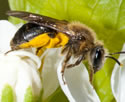 Andrena spp. on Wild Plum
Andrena spp. on Wild Plum
Photos courtesy Peter M. Dziuk taken in Anoka, Douglas and Ramsey counties. Pollinator photos courtesy Heather Holm.
Comments
Have you seen this plant in Minnesota, or have any other comments about it?
on: 2015-08-27 21:09:20
Found this wild plum tree not far from the Mississippi river in Ramsey, MN.
on: 2016-05-28 12:32:00
It is growing wild along the lakeshore that floods seasonally.
on: 2016-12-16 17:25:46
Not a good landscape tree. I once bought five trees and planted them in my yard. After a few years I noticed shoots popping up 30 feet away and realized that they have total colonization in mind. I had a very difficult time eradicating them all. Be careful where you plant them. They do not make for good neighbors.
on: 2017-08-24 14:37:53
Found a few growing along the shoreline of the Rum River Most of the fruits had fallen off. End of August.
on: 2017-12-04 07:49:19
I'm battling buckthorn and wondering if wild plum has the same orange inner bark that buckthorn does? I scratch the bark and if it's orange it goes I'm hoping I'm correct with that judgment.
on: 2017-12-04 10:38:42
Greg, check the common buckthorn page for other distinguishing characteristics of dormant plants, such as the buds.
on: 2018-08-20 18:07:29
2018 was first year a wild plum tree flowered and produced fruit on our property.
on: 2018-08-26 12:50:38
Found 2 fully fruited trees in Walker along the Paul Bunyan Bicycle Trail.
on: 2018-09-02 12:28:01
I'm looking for started wild plum trees to purchase. Also looking for wild plums this season to pick. Thank you.
on: 2018-09-02 12:39:41
Jeri, we do not track who sells what, so check "where to buy native plants and seeds" that is on most pages of the website. If those vendors do not have what you're looking for perhaps one knows who does.
on: 2019-04-01 15:14:11
I have one growing wild in my back yard amongst the boxelder trees. It has beautiful fragrant flowers in the spring and the fruits make great jam that tastes like apricots. The mature fruits are a yellow orange color-some get slightly red.
on: 2019-07-26 12:27:01
There are two growing in my Mother's yard, in Coon Rapids. I know they've been there for at least 30 years.
on: 2019-08-17 14:38:42
Found the plum tree at the Rapids Lake Visitor Center of MNVNWF.
on: 2019-08-24 09:43:10
Pick and make jelly and syrup. Seems like two kinds of here. One a tree and other like Bush. One is sweet other bitter. Tree the best 3 gallons today. Use tarp and shake tree
on: 2020-08-15 18:55:40
I have lived here 23 years and noticed on the edge of the yard for the first time small plums. I remember the blossoms earlier thinking I wonder what that is. Ten plums total this year.
on: 2020-09-17 20:07:33
We have one in our back yard. It has produced fruit off and on when I prune. The trunk is growing almost horizontally so I'm not quite sure what to do with it.
on: 2020-12-14 20:01:29
Found two thickets in the ravine park running south of Kingston park, growing along the east edge of the paved trail. Was able to harvest 2+ pounds three times in September. In late November or early December, the City or County was clearing out brush, bushes, and trees, and completely cut down these thickets. I am told that they will resprout, but it will take them a while to be mature enough to produce. With any luck I'll find some others nearby. They made a great tangy-sweet jam.
on: 2021-06-06 11:36:17
Found a few trees surrounding picnic table platform.
on: 2021-07-17 08:32:32
Found a patch in my prairie. Pretty sure this is what they are...
on: 2021-08-13 07:34:19
My husband and I bought our first home in October of 2017. Upon inspection we discovered the "giant bushes" in the middle of the yard were actually 10 wild plum trees. We trimmed them up and have been enjoying making jelly ever since to share with friends and family.
on: 2022-01-20 11:32:47
I would like to know where I could get a few wild plums without doing something environmentally unfriendly such as accidentally buying a cultivar. I want something that it would be okay if it spread to nearby wild areas.
on: 2022-01-20 12:01:50
Naomi, we do not track who sells what, but see "where to buy native plants and seeds" that is shown on most web pages here, or the list of native plant vendors. I am sure some of those nurseries carry native plums.
on: 2023-05-09 20:27:12
Do the spines differentiate these from the Canada plums? We have some with awful spines, like what's pictured; but they haven't formed thickets even though they border our woods and are well established. We assumed the original owners planted them, but I don't know why anyone would deliberately choose this variety. They're very hard to manage because of the spines.
on: 2023-05-10 05:19:11
Debbie, the spines are not a feature of any particular variety, but are naturally occurring in the species. Both American and Canada plum have them.
on: 2023-08-13 20:07:32
Have one as a polinator.Its 7 years old.Sandy soil here along mississippi river. Plentiful flowers early spring brings lots of tiny bees. Fruit is very very sweet. Its the fist to flower of pears, cherry,and apple trees.
on: 2024-01-18 11:26:52
There was a plum tree north of Hinckley on the walk to the track/baseball field near Kettle River. Used to grab a couple on the way to practice - delicious!






